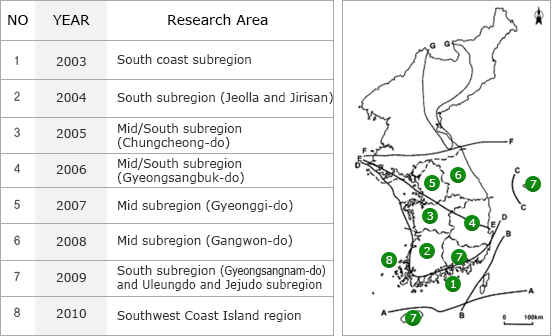- 글로벌메뉴
- KOREAN

 Korea Biodiversity Information System > Plant Resource > Distribution Information > Distribution of Korean Vascular Plants
Korea Biodiversity Information System > Plant Resource > Distribution Information > Distribution of Korean Vascular Plants
At the COP 10 in 2010, the Nagoya protocol for Access and Benefit Sharing (ABS) of genetic resources was adopted and announced. This agreement is considered to establish an international policy for the utilization of biological resources through PIC and MAT. Accordingly, in order to protect the rights to their biological resources, each nation is strengthening its biological management, including making systematic surveys of biological resources, constructing databases, and passing legislation.
To establish our biological resource sovereignty and exercise our rights, Korea should prepare a systematic, national-level preservation and management strategy. It is considered that securing distribution information and evidence specimens through systematic and comprehensive investigation of plant resources growing in Korea will be fundamental for this.
Based on this, the Korea Forest Service and National Arboretum divided Korea into 10 districts (South Coast, Jeolla, Choongchung, Gyeongbuk, Gyeonggi, Gangwon, Gyeongnam, Ulleungdo, Jejudo, and West Coast), and since 2003 has conducted investigations on the distribution of vascular plants in each district, and has published a "Korean Peninsula vascular plant distribution chart" based on the results every year.

Experts from 10 organizations investigated regional plant distribution annually, and a plant list was created based on the evidence specimens. Specimens collected by region were cross-identified and reviewed by experts in each taxon to enhance the accuracy of the results.

The distribution of 2,600 plant species at 560 sites in Korea was confirmed, and about 12,000 evidence specimens were secured and stored in the National Arboretum and with each organization. The study results were made into nine illustrated books on distribution and were distributed to related organizations.
Among the 47% of unidentified plant species (2,280 species out of 4,880 species based on National Standard Plant list) from the previous eight years of investigation, 400 species distributed in North Korea and about 1,500 species unrelated to cultivating species are currently undergoing meticulous research focusing on their distribution and colony identification. Moreover, it is planned to create a list of integrated Korean Peninsula distribution information based on evidence specimens collected from annual local plant investigations by taxa.
Kangwon University, Kyungnam University, Kyungbook National University, Konju University, the National Arboretum, Daejeon University, Daejin University, SNU, Semyung University, Sin Gyung University, Andong University, Inha University, Chonnam University, Chungbuk University, Hannam University, Hallym University
